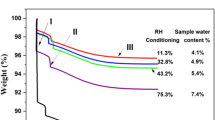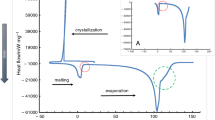Abstract
The hydration of cellulose, chitosan, schizophyllan, hyaluronan, and carboxymethyl cellulose was studied using differential scanning calorimetry (DSC). In the first part, the classical freezing/thawing approach was used to determine the amount of non-freezing water. The inconsistency in enthalpies obtained during crystallization and melting of freezable water was discussed with respect to the DSC experimental conditions. Our interpretation questions the recent conclusions about competitive processes occurring during melting which are hypothesized to influence the determined melting enthalpy. In the second part, the hydration and drying were studied using the evaporation enthalpy of water. The dry mass normalized dependency of vaporization enthalpy on water content confirmed an abrupt break at low water content in hyaluronan sample which was attributed to the sudden appearance of a parallel process taking part during the drying. The rest of polysaccharide samples showed only a linear decrease in evaporation enthalpy. The renormalization of enthalpies by the water content revealed the increase in evaporation enthalpy with decreasing water content in most samples which was ascribed to the strong interaction between polysaccharide and water. The exceptions were carboxymethyl cellulose which showed a decrease in evaporation enthalpy. This indicates the existence of a simultaneous process occurring during drying, but unlike in hyaluronan, the processes do not appear abruptly but accompany the evaporation in the wide concentration range. Comparison of determined hydration numbers showed that part of non-freezing water in hyaluronan is not bound to sorption sites but occurs presumably in small temporary pores. In contrast, water-soluble schizophyllan forms temporary pores as well but presumably with higher dimension and the non-freezing water is formed mostly by water molecules interacting with sorption sites.








Similar content being viewed by others
References
Cavallaro G, Donato DI, Lazzara G, Milioto S. Films of halloysite nanotubes sandwiched between two layers of biopolymer: from the morphology to the dielectric, thermal, transparency, and wettability properties. J Phys Chem C. 2011;115:20491–8.
Cavallaro G, Lazzara G, Milioto S. Dispersions of nanoclays of different shapes into aqueous and solid biopolymeric matrices. Extended physicochemical study. Langmuir. 2011;27:1158–67.
Dammström S, Salmén L, Gatenholm P. The effect of moisture on the dynamical mechanical properties of bacterial cellulose/glucuronoxylan nanocomposites. Polymer. 2005;46:10364–71.
Gocho H, Shimizu H, Tanioka A, Chou TJ, Nakajima T. Effect of polymer chain end on sorption isotherm of water by chitosan. Carbohydr Polym. 2000;41:87–90.
Blicharska B, Peemoeller H, Witek M. Hydration water dynamics in biopolymers from NMR relaxation in the rotating frame. J Magn Reson. 2010;207:287–93.
Mracek A, Benesova K, Minarik A, Urban P, Lapcik L. The diffusion process of sodium hyaluronate (Na-HA) and Na-HA-n-alkyl derivatives films swelling. J Biomed Mater Res Part A. 2007;83A(1):184–90.
Hatakeyama T, Nakamura K, Hatakeyama H. Vaporization of bound water associated with cellulose fibers. Thermochim Acta. 2000;352–353:233–9.
Hatakeyama H, Hatakeyama T. Interaction between water and hydrophilic polymers. Thermochim Acta. 1998;308:3–22.
Hatakeyama T, Hatakeyama H, Nakamura K. Non-freezing water content of mono- and divalent cation salts of polyelectrolyte–water systems studied by DSC. Thermochim Acta. 1995;253:137–48.
Takahashi M, Hatakeyama T, Hatakeyama H. Phenomenological theory describing the behaviour of non-freezing water in structure formation process of polysaccharide aqueous solutions. Carbohydr Polym. 2000;41:91–5.
Průšová A, Conte P, Kučerík J, Alonzo G. Dynamics of hyaluronan aqueous solutions as assessed by fast field cycling NMR relaxometry. Anal Bioanal Chem. 2010;397:3023–8.
Hunger J, Bernecker A, Bakker HJ, Bonn M, Richter R. Hydration dynamics of hyaluronan and dextran. Biophys J. 2012;103:L10–L12.
Maréchal Y, Milas M, Rinaudo M. Hydration of hyaluronan polysaccharide observed by IR spectrometry. III. Structure and mechanism of hydration. Biopolymers. 2003;72:162–73.
Mracek A, Varhanikova J, Lehocky M, Grundelova L, Pokopcova A, Velebny V. The influence of Hofmeister series ions on hyaluronan swelling and viscosity. Molecules. 2008;13(5):1025–34.
Mazeau K, Rinaudo M. The prediction of the characteristics of some polysaccharides from molecular modeling. Comparison with effective behavior. Food Hydrocolloid. 2004;18:885–98.
Takigami S, Takigami M, Phillips GO. Hydration characteristics of the cross-linked hyaluronan derivative hylan. Carbohydr Polym. 1993;22:153–60.
Takigami S, Takigami M, Phillips GO. Effect of preparation method on the hydration characteristics of hylan and comparison with another highly cross-linked polysaccharide, gum arabic. Carbohydr Polym. 1995;26:11–8.
Kučerík J, Průšová A, Rotaru A, Flimel K, Janeček J, Conte P. DSC study on hyaluronan drying and hydration. Thermochim Acta. 2011;523(1–2):245–9.
Belton PS. NMR and the mobility of water in polysaccharide gels. Int J Biol Macromol. 1997;21:81–8.
Gemmei-Ide M, Ohya A, Kitano H. Thermally latent water in a polymer matrix. J Phys Chem B. 2010;114:4310–2.
Prusova A, Smejkalova D, Chytil M, Velebny V, Kucerik J. An alternative DSC approach to study hydration of hyaluronan. Carbohydr Polym. 2010;82(2):498–503.
Park S, Venditti RA, Jameel H, Pawlak JJ. Changes in pore size distribution during the drying of cellulose fibers as measured by differential scanning calorimetry. Carbohydr Polym. 2006;66(1):97–103.
Prado JR, Vyazovkin S. Activation energies of water vaporization from the bulk and from laponite, montmorillonite, and chitosan powders. Thermochim Acta. 2011;524(1–2):197–201.
Park S, Venditti RA, Jameel H, Pawlak JJ. Studies of the heat of vaporization of water associated with cellulose fibers characterized by thermal analysis. Cellulose. 2007;14(3):195–204.
Ghosh A, Ali MA, Walls R. Modification of microstructural morphology and physical performance of chitosan films. Int J Biol Macromol. 2010;46:179–86.
Nishinari K, Takahashi R. Interaction in polysaccharide solutions and gels. Curr Opin Colloid Interface Sci. 2003;8:396–400.
Kony DB, Damm W, Stoll S, van Gunsteren WF, Hűnenberger PH. Explicit-solvent molecular dynamics simulations of the polysaccharide schizophyllan in water. Biophys J. 2007;93:442–55.
Robert L, Robert A-M, Renard G. Biological effects of hyaluronan in connective tissues, eye, skin, venous wall. Role in aging. Pathol Biol. 2010;58:187–98.
Nikolakakis I, Tsarvouli K, Malamataris S. Water retention and drainage in different brands of microcrystalline cellulose: effect of measuring conditions. Eur J Pharm Biopharm. 2006;63:278–87.
Liu P, Zhai M, Li J, Peng J, Wu J. Radiation preparation and swelling behavior of sodium carboxymethyl cellulose hydrogels. Radiat Phys Chem. 2002;63:525–8.
Liu J, Cowman MK. Thermal analysis of semi-dilute hyaluronan solutions. J Therm Anal Calorim. 2000;59:547–57.
Della Gatta G, Richardson MJ, Sarge SM, Stolen S. Standards, calibration, and guidelines in microcalorimetry—Part 2 calibration standards for differential scanning calorimetry—(IUPAC Technical Report). Pure Appl Chem. 2006;78:1455–76.
Faroongsarng D, Sukonrat P. Thermal behavior of water in the selected starch- and cellulose-based polymeric hydrogels. Int J Pharm. 2008;352:152–8.
Qu X, Wirsén A, Albertsson AC. Novel pH-sensitive chitosan hydrogels: swelling behavior and states of water. Polymer. 2000;41:4589–98.
Kučerík J, Bursáková P, Průšová A, Grebíková L, Schaumann GE. Hydration of humic and fulvic acids studied by DSC. J Therm Anal Calorim. 2012;110:451–9.
Cowman MK, Matsuoka S. Experimental approaches to hyaluronan structure. Carbohydr Res. 2005;340:791–809.
Hargittai I, Hargittai M. Molecular structure of hyaluronan: an introduction. Struct Chem. 2008;19:697–717.
Marsh KN. Recommended reference materials for the realization of physicochemical properties. Oxford: Blackwell; 1987.
Kohl I, Mayer E, Hallbrucker A. The glassy water-cubic ice system: a comparative study by X-ray diffraction and differential scanning calorimetry. Phys Chem Chem Phys. 2000;2:1579–86.
Kerch G, Glonin A, Zicans J, Meri RM. A DSC study of the effect of ascorbic acid on bound water content and distribution in chitosan-enriched bread rolls during storage. J Therm Anal Calorim. 2012;108:73–8.
Acknowledgements
This work was financially supported by the Ministry of Education, Youth and Sport of the Czech Republic project no. 0021630501. Authors would like to thank Dr. Vladimir Velebný from CPN Company, Dolní Dobrouč, Czech Republic for providing hyaluronan and schizophyllan samples and to Ms. Alena Prusova for the help with evaporation experiments.
Author information
Authors and Affiliations
Corresponding author
Rights and permissions
About this article
Cite this article
Mlčoch, T., Kučerík, J. Hydration and drying of various polysaccharides studied using DSC. J Therm Anal Calorim 113, 1177–1185 (2013). https://doi.org/10.1007/s10973-013-2946-1
Received:
Accepted:
Published:
Issue Date:
DOI: https://doi.org/10.1007/s10973-013-2946-1




